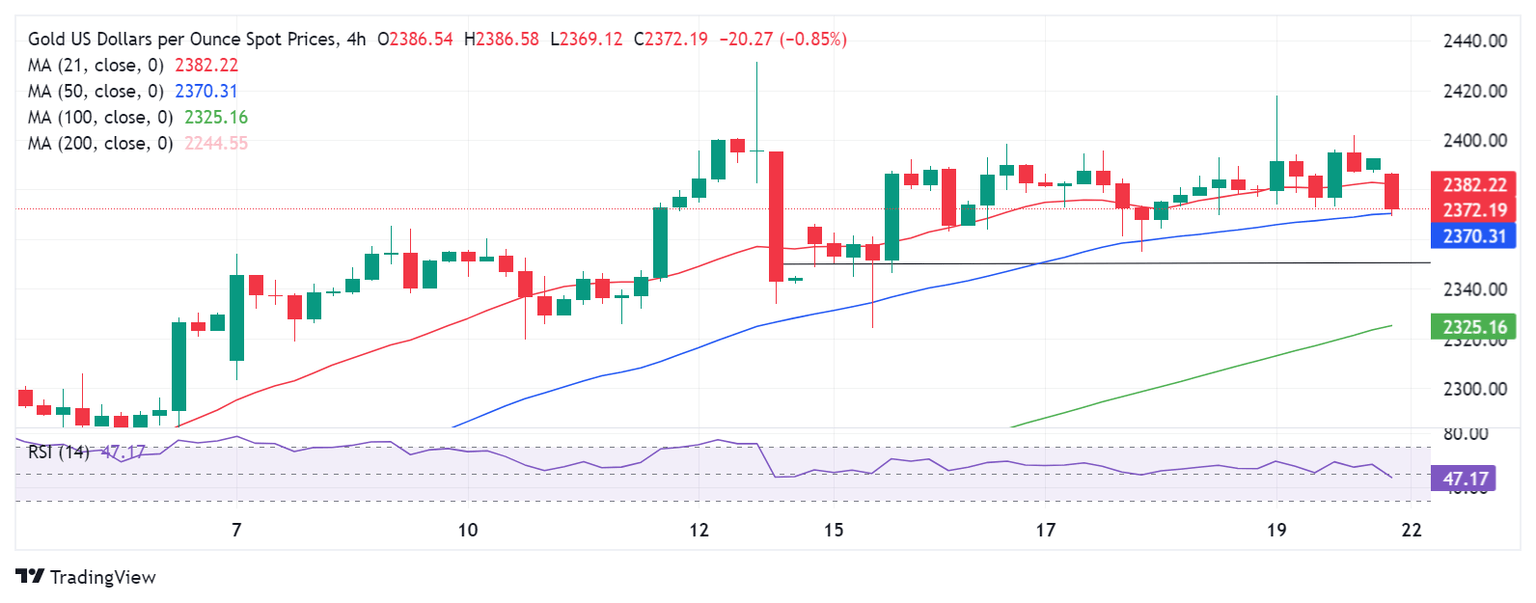Gold Price Forecast: XAU/USD returns to the red after failing above $2,400 yet again
- Gold price extends pullback as Middle East fears calm down.
- US Dollar weakens amid upbeat mood, despite rebounding US Treasury bond yields.
- Gold price targets $2,350 on a sustained break below 50-SMA at $2,370 on the 4H chart.

Gold price has returned to the red in Monday’s Asian trading, snapping two back-to-back days of gains. The extended Gold price pullback could be attrbuted to a renewed uptick in the US Treasury bond yields, as markets calm down after no further geopolitical escalation in the Middle East over the weekend.
Focus shifts to top-tier US events this week
Reports on early Friday that Israeli missiles struck a site in Iran, per ABC News, citing a US official, triggered broad risk-aversion. However, no official comments from Israel confirming the same and denial by Iranian authorities turned markets into a risk reset mode.
Gold price initially spiked up to near $2,420 on mounting geopolitical risks but pulled back to settle below the $2,400 threshold, as risk sentiment recovered. The sharp turn around in the US Dollar and the US Treasury bond yields also contributed to the retracement in Gold price last Friday.
In Monday’s trading so far, investors are breathing a sigh of relief amid a likely thaw in the Israel-Iran conflict, helping risk flows to return. The People’s Bank of China (PBOC) left the key Loan Prime Rates unchanged, although failed to deter the risk-on market mood.
Gold price moves further away from the record highs of $2,432 even though the US Dollar stays defensive on risk appetite. The reduction in the demand for another safe-haven asset, the US Treasury bonds, fuels a fresh upswing in the US Treasury bond yields, accentuating the corrective decline in Gold price.
Later in the day, if the US Dollar finds renewed demand, courtesy of firmer US Treasury bond yields, Gold price pullback could gain momentum. The US economic calendar is devoid of any top-tier data releases on Monday, and hence, risk sentiment and the US Dollar dynamics will continue to influence the Gold price action.
Meanwhile, the US Federal Reserve (Fed) entered its ‘blackout period’ on Saturday, ahead of the May 1 policy announcements. Geopolitical developments will also draw investors’ attention.
Gold price technical analysis: Four-hour chart
As observed on the four-hour chart, Gold price has pierced through the 21-Simple Moving Average (SMA) at $2,382 to challenge the next key support at $2,370 – the 50-day SMA.
A four-hourly candlestick closing below the latter could initiate a fresh downtrend toward the 100-SMA at $2,325. At that level, the April 15 low concurs.
However, Gold sellers need to crack the $2,350 psychological level beforehand.
The Relative Strength Index (RSI), a leading indicator, has entered the negative territory to hover near 48.00, justifying the bearish potential.
On the flip side, Gold price could face the initial hurlde at the 21-SMA at $2,382 (previous support now resistance) on the road to recovery. Further up, the $24,00 round level will be challenged.
Acceptance above the latter will fuel a fresh upswing for a test of Friday’s high of $2,418. Further up, the lifetime highs of $2,432 will come into play.
Gold FAQs
Gold has played a key role in human’s history as it has been widely used as a store of value and medium of exchange. Currently, apart from its shine and usage for jewelry, the precious metal is widely seen as a safe-haven asset, meaning that it is considered a good investment during turbulent times. Gold is also widely seen as a hedge against inflation and against depreciating currencies as it doesn’t rely on any specific issuer or government.
Central banks are the biggest Gold holders. In their aim to support their currencies in turbulent times, central banks tend to diversify their reserves and buy Gold to improve the perceived strength of the economy and the currency. High Gold reserves can be a source of trust for a country’s solvency. Central banks added 1,136 tonnes of Gold worth around $70 billion to their reserves in 2022, according to data from the World Gold Council. This is the highest yearly purchase since records began. Central banks from emerging economies such as China, India and Turkey are quickly increasing their Gold reserves.
Gold has an inverse correlation with the US Dollar and US Treasuries, which are both major reserve and safe-haven assets. When the Dollar depreciates, Gold tends to rise, enabling investors and central banks to diversify their assets in turbulent times. Gold is also inversely correlated with risk assets. A rally in the stock market tends to weaken Gold price, while sell-offs in riskier markets tend to favor the precious metal.
The price can move due to a wide range of factors. Geopolitical instability or fears of a deep recession can quickly make Gold price escalate due to its safe-haven status. As a yield-less asset, Gold tends to rise with lower interest rates, while higher cost of money usually weighs down on the yellow metal. Still, most moves depend on how the US Dollar (USD) behaves as the asset is priced in dollars (XAU/USD). A strong Dollar tends to keep the price of Gold controlled, whereas a weaker Dollar is likely to push Gold prices up.
Premium
You have reached your limit of 3 free articles for this month.
Start your subscription and get access to all our original articles.
Author

Dhwani Mehta
FXStreet
Residing in Mumbai (India), Dhwani is a Senior Analyst and Manager of the Asian session at FXStreet. She has over 10 years of experience in analyzing and covering the global financial markets, with specialization in Forex and commodities markets.


















